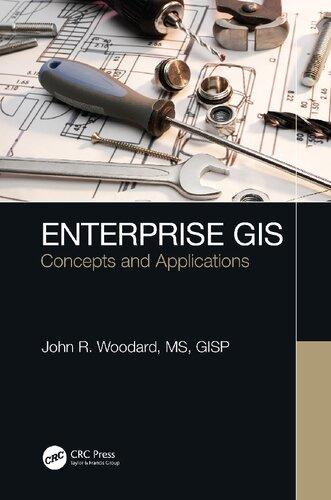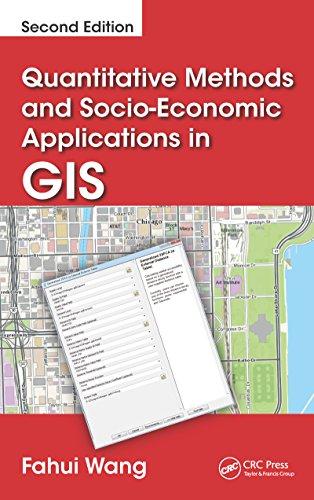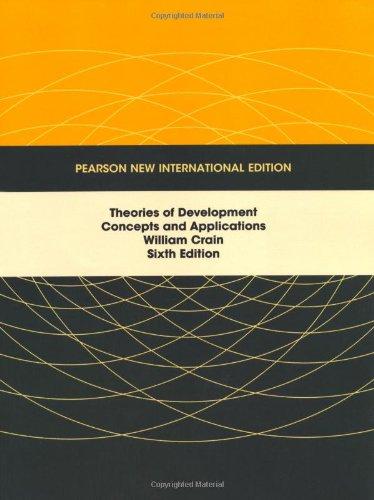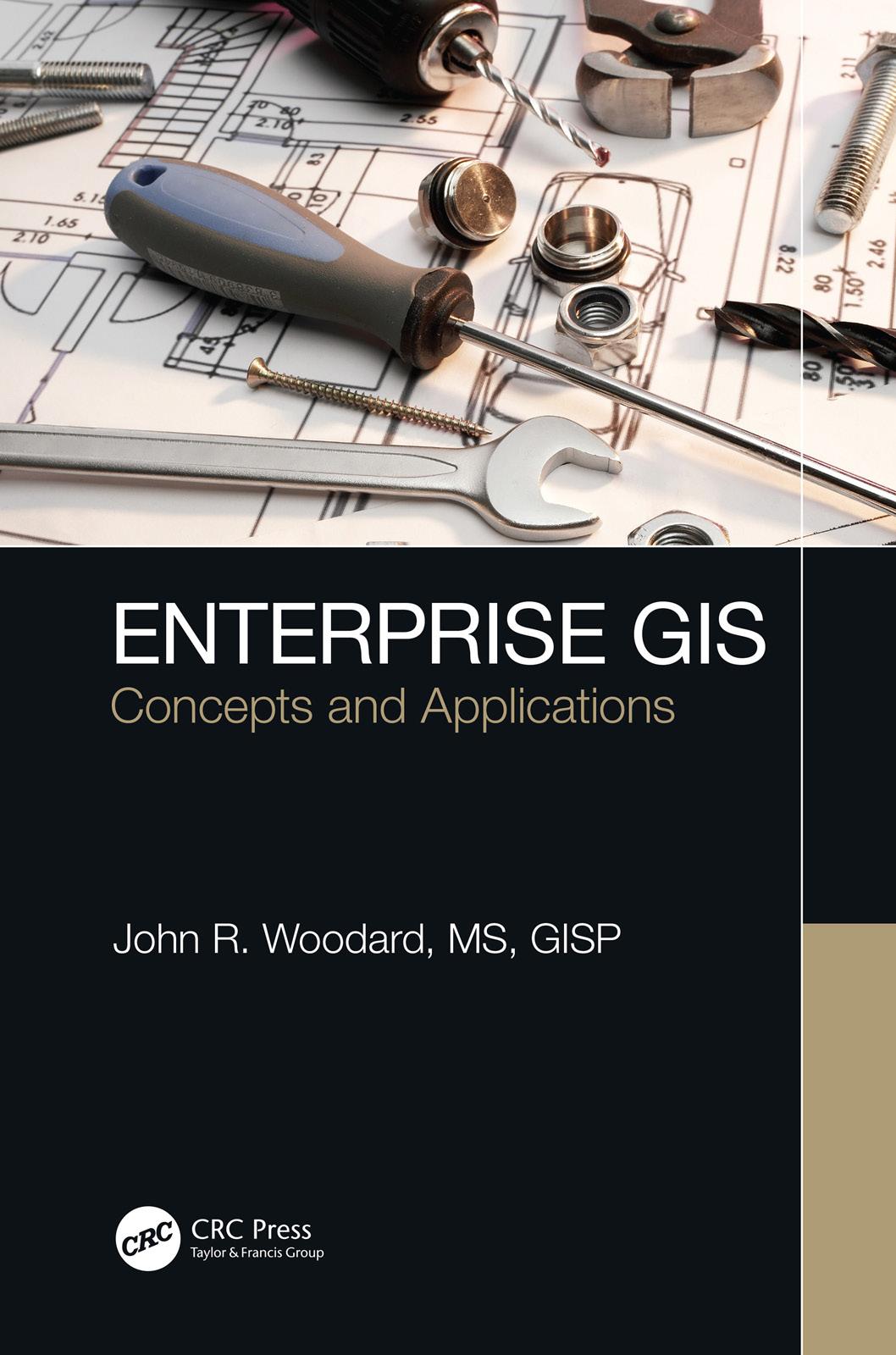Enterprise GIS
Concepts and Applications
by John R. Woodard MS, GISP
CRC Press
Taylor & Francis Group
6000 Broken Sound Parkway NW, Suite 300
Boca Raton, FL 33487-2742
© 2020 by Taylor & Francis Group, LLC
CRC Press is an imprint of Taylor & Francis Group, an Informa business
No claim to original U.S. Government works
Printed on acid-free paper
International Standard Book Number-13: 978-1-138-47829-9 (Hardback)
This book contains information obtained from authentic and highly regarded sources. Reasonable efforts have been made to publish reliable data and information, but the author and publisher cannot assume responsibility for the validity of all materials or the consequences of their use. The authors and publishers have attempted to trace the copyright holders of all material reproduced in this publication and apologize to copyright holders if permission to publish in this form has not been obtained. If any copyright material has not been acknowledged, please write and let us know so we may rectify in any future reprint.
Except as permitted under U.S. Copyright Law, no part of this book may be reprinted, reproduced, transmitted, or utilized in any form by any electronic, mechanical, or other means, now known or hereafter invented, including photocopying, microfilming, and recording, or in any information storage or retrieval system, without written permission from the publishers.
For permission to photocopy or use material electronically from this work, please access www.copyright.com (http://www.copyright.com/) or contact the Copyright Clearance Center, Inc. (CCC), 222 Rosewood Drive, Danvers, MA 01923, 978-750-8400. CCC is a not-for-profit organization that provides licenses and registration for a variety of users. For organizations that have been granted a photocopy license by the CCC, a separate system of payment has been arranged.
Trademark Notice: Product or corporate names may be trademarks or registered trademarks, and are used only for identification and explanation without intent to infringe.
Visit the Taylor & Francis Web site at http://www.taylorandfrancis.com
and the CRC Press Web site at http://www.crcpress.com
Dedication
This book is dedicated to my wife and my parents. For their endless love, support, patience, and encouragement during this writing process.
List of Figures
Preface
Many people have asked, “Why?” Why this book about enterprise architecture for geographic information systems? ESRI has already created these systems! There are many books about enterprise architecture and operations. These are valid questions, and they deserve answers.
This textbook is intended as a helpful aid for GIS professionals and users searching for ways to improve themselves and information systems. This book is a way of giving back to the people who taught, encouraged, and sometimes provided a proper kick to “you know where,” when this author required proper motivation.
These same people (professors, teachers, Seabees, farmers, and laborers) also instilled the professional ideals of hard work, responsibility, accountability, helping others, and pride, in an inexperienced newbie. This book also seeks to honor their efforts, with a tool for tomorrow’s professionals.
Smoothing the path for those behind you is one of those professional responsibilities everyone seems to discuss, but only a few people practice. This book will hopefully help smooth the rough spots in the paths of future enterprise GIS builds and ensure a smoother transition from a simple desktop to an organizational information system. The author’s understanding and methodologies in developing enterprise systems come from developing several municipal GIS systems and a second master’s degree in digital science concentrated upon enterprise architecture.
Continuing education is one of the secrets to becoming a well-rounded professional. Scuba divers have a magazine Dive Training, which has the motto “A good diver is always learning!” This author has not only lived by, and trained for scuba following, the slogan but adapted it for the field of GIS, “A good GISer, is always learning!” This phrase can be applied or act as a slogan for any professional regardless of profession.
Acknowledgments
First and foremost, I would like to thank my wife for her love and willingness to sacrifice “our time” to enable me to finish writing this project.
I would like to thank my parents for their support and help; they were there when I needed them.
A very special thank you to Dr. Tyner! Without his suggestions and encouragement this book would never have been written.
Thank you to the partners/owners of my former company, Chagrin Valley Engineering, Ltd. (CVE). They provided support, encouragement, and the space to fail, when developing enterprise GIS. They graciously allowed me to use CVE project sheets as appendices for this book.
I would like to say thank you to my current employer Davey Resource Group, Inc. (DRG) and The City of Oberlin, Ohio Public Works Department for their support and for allowing me to use Oberlin’s project sheet as an appendix for this book.
A special thank you to Ms. Tabitha Messmore for being a “go-to” mentor and advisor.
A special thank you to Mrs. Debbie Sheeler for her encouragement and support.
A special thank you to Dr. Denise Bedford who introduced me to the field of enterprise architecture and who provided timely insights, encouragement, and templates for many enterprise and business architecture models.
Thank you to all my friends, who encouraged me along the way and never let me forget how far I had come, during moments of self-doubt. Your friendship has provided me with many wonderful adventures, experiences, and memories that helped me through the hard times.
Thank you, Lord, for providing me with all these wonderful people in my life, and for always being there for me.
John R. Woodard MS, GISP
Author
John R . Woodard, MS, GISP has worked in the field of geographic information systems (GIS) since 2002. He was fortunate enough to be offered a position with the Summit County Health Department’s Community Health Division. John was responsible for planning, implementing, and coordinating all GIS activities for the Health Department. A high point in his time with Summit County Health was managing a multi-agency project composed of nurses, administrators, and first responders to create an interactive disaster/terrorism response map. This interactive map was designed to provide first responders information about nearby facilities and assets in a time of emergency.
He spent 10 years with Chagrin Valley Engineering, forming a close working relationship with clients, engineers, and field crews. This is where he became interested in working with enterprise architecture as a foundation for enterprise GIS systems. He was responsible for designing, building, and maintaining enterprise GIS systems for 14 municipalities in Northeast Ohio. His excellent work for The City of Avon was recognized with a GIS Best Practice award from the Ohio Geographically Referenced Information Program (OGRIP) in 2016.
Mr. Woodard firmly believes in continuing education and helping others. Since May 2003, he has held the position of Adjunct Faculty at the Northeast Ohio Medical University, Rootstown, Ohio. During this time, he completed a master’s degree in GIS/Geography from the University of Akron and a master’s degree in digital science concentrated in enterprise architecture from Kent State University, Kent, Ohio. He was awarded his certification as a GIS Professional (GISP) in 2015.
John has had a varied career outside of the field of GIS. He serviced with the United States Navy Reserve Seabees from 1995 to 2005 and has pursued the hobbies of scuba diving and beekeeping. He currently is employed with Davey Resource Group Ltd as a Project Developer for the GIS/IT division. John lives at home in Ohio with a beautiful wife and 20-month-old daughter.
1 Introduction and Organization
1.1 Introduction
This book does not advocate “scrapping” enterprise geographic information system (EGIS) systems but will demonstrate how GIS benefits through the use of enterprise architecture (EA) theories, ideas, and methodologies. Many people feel that when more than one computer is connected to a dataset, sharing files and printers between people or departments constitutes an enterprise system. This is far from the truth, particularly in the field of GIS, where people play fast and loose with file-naming conventions, organization, or formatting. These systems are plagued with improper file names, inefficient or duplicated pathways, incorrect data, or damaged files, and there is the potential for many other problems.
Any information system that has these problems will not succeed. The system will be inefficient, slow to respond, and provide bad data when making decisions. Problems like duplicated pathways to files can dramatically slow system response time, yet remain hidden from a low-level scan. Over time, these problems will have a cumulative impact on system performance, ultimately leading to failure. Attempting to work with a system containing flaws would be the same as shooting oneself in the foot.
People only seem to notice a system’s problems after it has been overwhelmed by preventable ones. Naturally, system failures always seem to happen during a “crisis or rush” situation where time is of the essence! A system that fails will have a decidedly negative impact on a user’s attempt to meet deadlines. Failure to meet a critical deadline will have a negative impact not only on the system, but on the professional depending on the system! Yes, everyone will miss a deadline once in a while and system failure will be accepted as a justifiable reason, once, or maybe twice. Repeated failures to meet deadlines will always fall back on the system user and blaming the system at that time will be viewed as nothing more than an excuse for their incompetence.
Information system failures will at the very least damage a person’s professional reputation, lead to being fired, or both.
System problems can be prevented, and reputations and jobs saved with the use of ideas and methods from the field of enterprise architecture! The best solution for solving problems is to prevent them from reaching the system. Enterprise architecture promotes a strategic plan for eliminating and preventing problems from occurring in an organization’s business systems. The purpose of enterprise architecture is to create a strategic plan that brings all of an organization’s assets, staff, and resources into one effort that supports the primary business mission.
A GIS is a powerful tool that supports the primary business mission. Poorly designed or implemented GISs are always plagued with problems in data, communication, duplicated efforts, files, processes, etc. These problems will cripple the functionality of any desktop or enterprise GIS. The author would like the reader to consider this truth that behind every successful information system is a well-executed enterprise architecture (plan). Enterprise architecture holds the keys to creating successful GISs. A few keys are strategic architecture, data architecture, data formats, standards, etc. The strategic or enterprise architecture is the keystone that begins and ties this system foundation together. Building a strong system foundation will require a thorough understanding of the similarities and differences between enterprise GIS and enterprise architecture.
A GIS professional can use these design keys to build enterprise GISs that are improved or enhanced with ideas from enterprise architecture. Enterprise GISs that are enhanced with enterprise architecture elements save money, provide a high return on investment, and operate with a high level of efficiency. GIS professionals can create information systems that are free of system errors, dependable, and filled with trusted information. The person who is responsible for developing and deploying a system that eliminates the problems of the “old way,” at a lower cost with a higher return on investment (ROI), is guaranteed to look like a superstar!
Enterprise GISs are primarily designed and implemented to provide GIS capabilities to departments and members of an organization. Unfortunately, too often, the users and managers of a GIS fail to provide an overarching goal or strategic purpose. Commercial software vendors, conference presentations, and academic authors’ papers and publications champion the virtues of an enterprise system. Many organizations simply lack the funding and staff resources to design and implement an enterprise system. Commercial software companies realize this fact, and promote the idea that their software can create an “out of the box” solution with a simple mouse click. These software companies peddling these “easy and simple” solutions have the goal of making a sale and locking the organization into a proprietary system. Proprietary software means that any updates, changes, or new applications must work (for a fee) with one company’s application. The client is forced to maintain a business relationship with this vendor regardless of the level of satisfaction with the product or service. Locking the client into a proprietary solution means a steady stream of revenue for the software company.
Academic presentations, publications, or papers always seem to deal with an idealistic world. It is a world where everyone has the finances, time, and manpower to simply create an organized system out of thin air! Academic people tend to believe that everyone has or soon will deploy an enterprise system. These papers and presentations promote the impression that everyone has developed a system or that it is fairly easy and quick to design the system. Everyone, commercial software vendors, consultants, or academic professionals overlook discussing and explain the process to develop and distribute a GIS with very little “how-to” details of system design.
There are GISs that are simply distributed throughout an organization. These are created when different departments or several people start working with GIS. This is not a true enterprise system or even a good way of sharing files. The problem with this “distributed” GIS is that if each person or department produces maps and data with no sense of organization or mutual project support, this ad hoc distributed GIS results in duplication of efforts, data, and results. There is chaos within the system as people produce large amounts of information without a sense of direction or value. Information that has no value is useless, which in turn means that all of the effort, time, and financial resources expended to produce this information was wasted.
Consider a county auditor’s dataset with information on land parcels within the county. Every week the parcel information (lines, ownership, etc.) must be updated. A data architecture to standardized or maintain data quality was never implemented. This lack of control has resulted in a dataset filled with problems. A lack of standardization of the names of parcel owners is one example of a data problem. A search of the parcel dataset revealed that municipal names were misspelled, incorrectly abbreviated, even listed as a village, or township instead of a city. Incorrect names for ownership create a situation where a query against the database will result in the wrong information being obtained. The wrong information, in turn, guarantees that any analysis performed on the corrupted information will lead to a bad result. A repeated pattern of poor decisions caused by bad information will result in a system that is no longer trusted.
Property boundaries (or parcel lines) populate the system with a very unique problem. The County Engineers’ office has the responsibility of ensuring that all of the boundaries defining property parcels are correct. However, the county auditor is tasked with maintaining all tax records, ownership, and related information to the property parcels. Two departments maintaining different types of information for the same dataset will have to deal with, if not a problem, miscommunication. When someone decides to combine or split a property parcel, the auditor’s staff updates the increase or decrease in the tax value of the parcel and then uses their GIS to modify the property. A simple change in the Auditor’s GIS will either split the parcel into two pieces or combine two parcels into one new parcel. This GIS process takes only a few minutes to execute, everything
is updated, new tax values, and ownership is updated! Amazing, it is all finished quickly or is it? The auditor’s parcel dataset has been updated with new information and even new boundaries for the properties impacted by the purchase. The reader should recall the fact that the engineer is responsible for maintaining the property boundaries!
This is where the problem occurs between the two departments. Legally, the engineer’s office cannot accept or make changes to any property boundary without a proper land survey. A legal process exists in every county that must be followed by the engineer’s office to ensure that property lines are properly measured, recorded, and certified by a professional surveyor. This process prevents the engineer’s staff from simply deleting or adding lines to a parcel map.
This creates the problem of two maps within the county depicting property information. One map represents the county as the auditor’s, who views properties via the tax information. The other map represents the county as the engineer’s, who views the properties via a certified survey. The auditor’s tax map will have all of the updated information for taxes, ownership, etc., but the parcel lines will not be legally correct. The engineer’s map naturally has the opposite situation, the parcel lines are correct, but all of the information for taxes, ownership, etc., will be out of date. This situation creates a huge amount of confusion for county planners, private developers, and members of the public.
An answer to the two-map situation is a data plan (architecture) that addresses the “how to” for updating parcel information. The best solution will be a process that allows both departments to edit the GIS parcel map simultaneously in real time. The process would require checks and balances. The first system check consists of a notice to the engineer that a change in a property boundary is requested. This request would begin a review of the property boundaries that will determine the amount of change required. A list of recommended or approved surveyors would be sent to the citizen initiating the process. The auditor’s staff could begin the update for the citizen with the understanding that nothing is approved or legally changed until the survey has been filed, approved, and accepted by the county engineer. This solution will result in accurate information for the tax map, while improving communication and coordination between the auditor’s and engineer’s departments.
Enterprise architecture focuses on providing organization and managing risk and change within a complex system. An organization’s architecture only succeeds if it achieves the total support or buy-in from departments and members (Wilson 2013). Clear and concise communication is critical to achieving buy-in from company stakeholders, and will enable the system to manage risk and adapt to today’s rapidly changing digital world. Company stakeholders, managers, and staff will not merely champion a new system on a designer’s word. Anyone who wishes to create and implement an enterprise system, especially an EGIS, must build trust with
everyone who will interact with the system. One can describe how the proposed system will save everyone time, respond quickly to queries, or support business analysis, etc. A financial analysis justifying the system through cost savings in labor, time, and resources, resulting in rising profits will result in the enterprise system getting a second look. Clear and concise communication can quickly explain to everyone how they all benefit by supporting a new system.
Everyone seems to understand the numbers of cost and time. Cost and time are intertwined and form two of the biggest issues when deploying a new system. However, they are your allies in defending the need for a system overhaul or build. This method of defending the need or cost of developing a new system is illustrated through the author’s own experience. Your author was asked to provide “real” numbers that a health department’s board would easily understand. The author’s approach was to break down the health department’s total expense for their personnel to inspect a septic system. First, the person inspecting was asked how many septic systems he inspected per day or week. The answer of four per week was very surprising!
The health department’s staff explained that searching through the old file cabinets (no digital records) took a lot of time. Two administrative assistants estimated that they each spent four hours researching the septic systems that needed inspection. The inspector estimated that he spent roughly four to six hours, reviewing their research, using Google Maps to view, and then determine the best route to the property parcel with the septic system. This meant that each septic system to be inspected required 8 plus 6 for a total of 14 man hours to simply research and locate the system. Therefore, the department was investing 56 hours (4 × 14) to inspect four septic systems! Let’s assume that the average hourly rate for each person on the project is $20.00 per hour. The total cost for four septic systems would be $1,120.00 and that is before the inspector leaves the office to inspect the septic system.
The author made the calculation that once an enterprise GIS was properly created and installed, the health department’s costs would show a dramatic drop. Administrative assistants would no longer need to sort through old file cabinets and handwritten notes. A simple click on the parcel would display hyperlink documentation for the parcel and septic system (time invested five minutes). They would then be able to review the information, print, or email the findings to the inspector. The inspector would no longer have to read through a book of documents at his desk, a simple mouse click would show all the information that required review (20 minutes per review). Now he could switch to the enterprise GIS link to Google Maps and simply click on route to determine the quickest path to the septic system to be inspected (30 minutes total). Now the total manhours expended is: 5 minutes (×2) = 10 + 20 + 30 = 60 minutes or 1 hour per inspection. Now the health department invested cost would be $20.00 × 1 hour = $20.00 per inspection setup.
When the client can see their costs drop from $1,120.00 to $20.00 per inspection many of the arguments against the new system will disappear.
Agility, flexibility, adaptability, and finding new ways to beat the competition to the profit is every businessman’s goal. One of the benefits of enterprise architecture is more clear lines of communication throughout the organization. A hierarchy of communication that defines who contacts who will eliminate the needless directory searches that cost time, money, and slow the company’s reaction time to market changes. A communication hierarchy enables decision-makers to learn about business problems or opportunities, assess the situation, make decisions, and then direct the company’s response to the circumstances.
There is a belief that if more than one department has access to GIS capabilities, then the company has developed an EGIS. This claim is accurate if one accepts the idea that the EGIS only provides tools to all levels of an organization. Unfortunately, this type of EGIS lacks the planning foundation that would give the system organization and direction. This system will contain many errors, duplicated data, redundant projects, etc. It will not be efficient and trusted, nor will it provide reliable support for business decisions.
The discipline of enterprise architecture can provide the organizational features that are missing from an enterprise GIS. Adding the theories, methodologies, and visions of enterprise architecture to enterprise GIS will align the system to support the organization’s goals. A skillful merger of enterprise architecture and GIS will bring order to a system in chaos.
The purpose of this book is to bridge the divide between the practitioners of enterprise architecture and GISs. Readers will learn some of the concepts, ideas, and methodologies of both enterprise architecture and GISs. The book will then introduce a method for merging these concepts to build an enterprise GIS over an enterprise architecture foundation.
1.2 Information sources
There are numerous publications, articles, online sources, and books available about enterprise and GISs systems. This section of the chapter presents an overview of some handy resources for someone embarking on the path for building an EGIS. GIS developers are concerned with ensuring that GIS capabilities are available to everyone in an organization. Providing everyone with some GIS capabilities is the cornerstone of the fundamental enterprise GIS. The company Environmental Research Institute (ESRI), the makers of the mapping software ArcGIS, defines EGIS as a system thoroughly integrated with all levels of an organization or company and a large number of users with GIS capabilities for managing, sharing, and using spatial data (ESRI 2007a).
This definition from ESRI explains the basic concept of enterprise GIS, and it does not go into great detail, nor does it mention of considering Data
Architecture and Governance. A lack of these two items limits the definitions as source material for designing or understanding an enterprise system.
There are many online sources for information about enterprise GIS. Most of these can be passed by as unreliable. However, there is one that deserves mention, and that is the GIS Encyclopedia located at www.Wiki.GIS.com. This website has 12 pages that relate to a phase in the System Design Process situated in the section “Enterprise System Design Planning Tools.” The encyclopedia does discuss system architecture design and also the importance of making sure that the GIS supports business strategy, goals, and information systems. It provides a quick overview of the design process with an overly simplified explanation of how to identify business needs and support requirements. It does finish with a nice warning that “trying to build a GIS without completing a proper system architecture design can lead to system deployment failure.” I have seen several systems that have fallen victim to the warning’s sentiment! Unlike other online resources, the GIS Encyclopedia is an ESRI online publication. When the manufacturer of software sets the standards in the field of GIS and the software is used by the majority of professionals, one can assume it will have useful information.
“OpenSource Enterprise GIS: An online OpenSource Enterprise GIS Manual” can be found at http://eos-gis.wikidot.com/tools is another online resource available to GIS designers. It lists pages devoted to strategy/planning, software, customization, and project management. There is a resource section that promises information on organizations and tools. Unfortunately, the site is minimal on resources and information.
Unfortunately, the OpenSource Enterprise GIS does not live up to that promise. Not one page under Chapters contains any useful or helpful information. The resource pages have links to only two organizations: The Open Source Geospatial Foundation and Codehaus; neither of which are concerned with enterprise GIS. The OpenSource Enterprise GIS is not a valuable resource for anyone wishing to learn, design, or implement a GIS.
“What’s Your Definition? Looking at What Enterprise GIS Means” by Christopher Thomas is a well-written piece that discusses people’s different ideas and definitions of enterprise GIS. Thomas has two critical criteria for determining when a system has matured to the enterprise level. First, the organization’s system is on a centralized database that receives contributions and updates from all departments (Thomas 2009). A centralized database that is accessed by everyone in the organization is the sign of a fully integrated GIS.
The second criterion is to have support from everyone in the organization. Total support or “buy-in” by executives and staff only happens when everyone feels that GIS is a critical tool and that they can be contributors to the system’s future growth, and receive valuable results from the system (Thomas 2009). When these two criteria are satisfied, the system has made the transition from a desktop or ad hoc application into a full enterprise GIS.
This article, although short, had some interesting points about the perception of what constitutes an enterprise GIS. I found this piece to be very informative, and it will help establish how to determine the threshold level for transitioning a GIS into an enterprise system. Thomas does provide a short look into how a GIS tends to grow within an organization.
R.E. Sieber discusses in his paper “GIS Implementation in the Grassroots” how an enterprise GIS develops. Sieber examines how grassroots conservation organizations implemented GISs and strategies over five years. The article points out that there are six critical factors to implementing a GIS: evaluation of need, executive support, resources dedicated to the project, training, and clear lines of communication throughout the implementation project (Sieber 2000). These are all critical areas of planning that cannot be ignored by anyone designing and implementing data or GIS architectures.
One key area that Sieber discusses is ensuring management’s support for the project. If people notice that managers and supervisors are learning the new technology, they will also attempt to accept the latest technology. However, if management shows no interest, then the project will encounter resistance from those who resist change. The article has an excellent point that the coordinator must not allow management to become “bogged down” by the technology. Otherwise, executives will be surprised by the amount of change and expense involved for implementing the system (Sieber 2000). Executives must always be kept aware of the cost and amount of difference to the organization that a new system creates. When managers are surprised about a change in price, they begin to question the validity of the project and might start to withdraw their support. A lack of support could lead to a new enterprise system’s implementation being delayed or canceled.
Kenneth Dueker and J. Butler in their article, “GIS-T Enterprise Data Model with Suggested Implementation Choices” examined how to build data models for enterprise-level GIS transportation systems. The article does an excellent job of laying out how a data model can be constructed to create geodatabases that support enterprise GIS. Dueker and Butler demonstrate that models are generally not seen by system users, but are critical components creating successful enterprise systems (Dueker 1997). Their data model can be applied to any information system and provides an excellent blueprint for people to track how the information will flow through the entire system.
Although the paper’s audience was intended to be designers and users or enterprise GIS transportation systems, their basic premise and methodology are adaptable to other GISs. The authors promote a universal data model that uses relationships between items in the GIS (Dueker 1997). A global model brings the advantages of clear communication between clients and users, simplifies requirements for software and vendor contracts, and allows integration within the business architecture (Dueker 1997).
The white paper “Enterprise GIS for Local Government” issued by ESRI in December 2007 provides a definition and guidelines on creating an enterprise GIS. ESRI recommends that implementation of an enterprise GIS
should consider existing organization standards. Methodologies, data procedures, and software applications need upgrading to versions that are compatible in the enterprise system. IT and GIS staff will need to be trained to support and work with the new system (ESRI 2007). The paper presents an excellent summary of each phase of the transition from the existing GIS into an enterprise GIS.
“Enterprise GIS for Local Government” presents a picture of the steps to be followed when an organization transition an existing GIS to an enterprise system. ESRI provides the reader with some solid ideas that are explained and clarified with some very nice graphics. Unfortunately, this paper does not address how to create a strategic plan for the enterprise GIS. It touches upon business architecture and intelligence but ultimately fails to describe how the enterprise system will support these two areas.
The publication “Best Practices: Enterprise GIS” (January 2007) provides a detailed explanation of how to design and create an enterprise GIS. A GIS professional who is overseeing the upgrade of an existing GIS into an enterprise GIS must evaluate each department’s dataset for completeness, the scope of information, accuracy, where and how the data can fit into an enterprise GIS (ESRI 2007). The publication is designed to provide an overview of the design process, and it does not delve into the details of architecture design.
ESRI’s “Best Practices: Enterprise GIS” provides several case studies that highlight successful enterprise GISs. “Kick-Starting Enterprise GIS” gives the impression that a reader will receive information on how to create momentum for his or her enterprise implementation project. Readers will be disappointed because the section does not contain a “how we did this project” (ESRI 2007) section. All of the case studies are summaries about each project. None of the case studies offer any solution or instructions on how to recreate the methodologies presented in the book.
1.3 Enterprise architecture
The field of GIS must be given the basic understanding of enterprise architecture if it is to adopt enterprise principles, methods, or ideas successfully. Anyone canvassing the internet will discover many websites or blogs offering slightly different versions of the same definition. Out of all of these definitions, I believe that Margaret Rouse’s explanation is concise and the easiest for everyone to understand: “An enterprise architecture (EA) is a conceptual blueprint that defines the structure and operation of an organization. Enterprise architecture intends to determine how an organization can most effectively achieve its current and future objectives” (Rouse 2007). The architecture is an organization’s strategic plan that determines how each company division, resource, or member can support the company’s primary goal.












